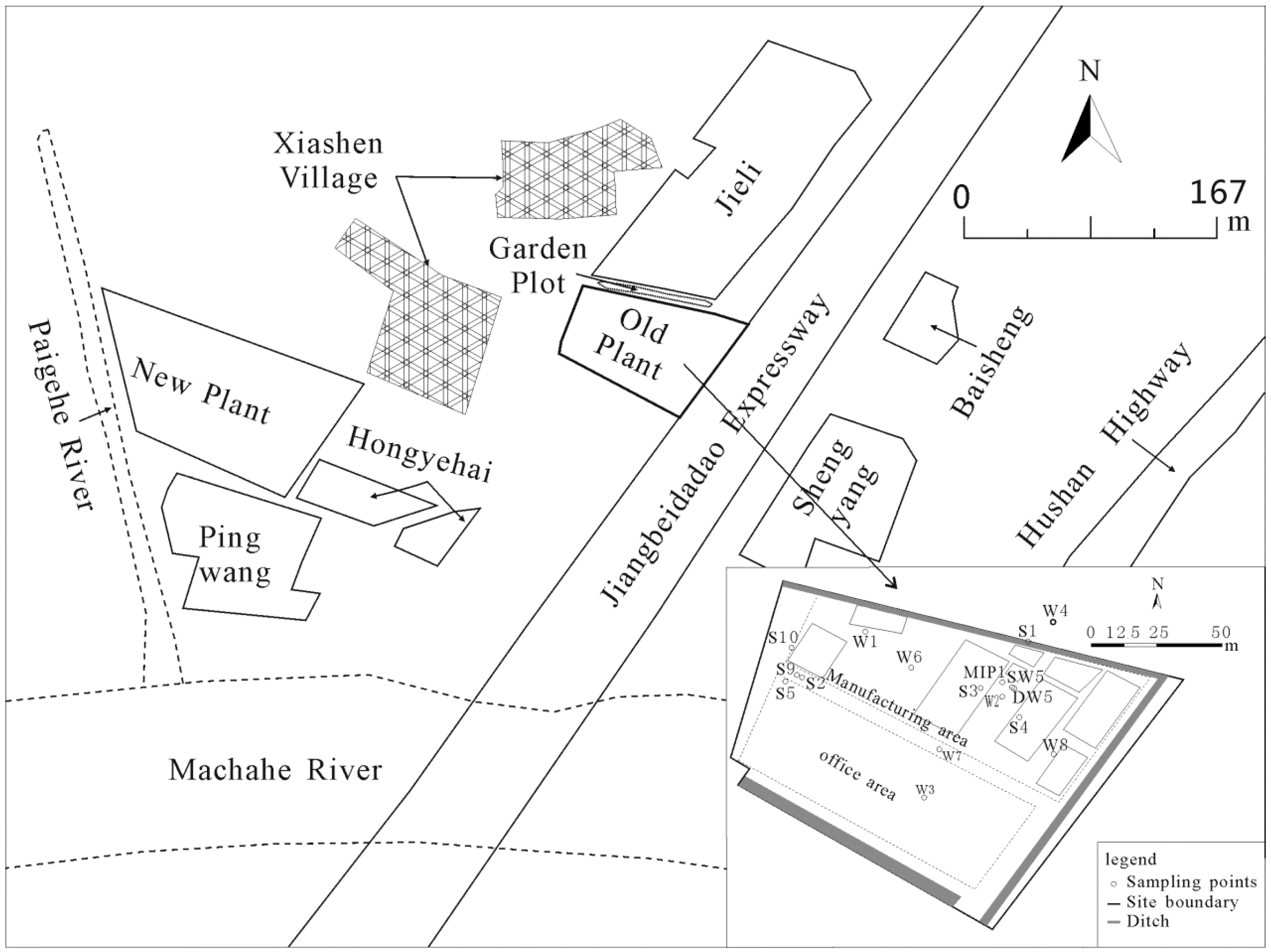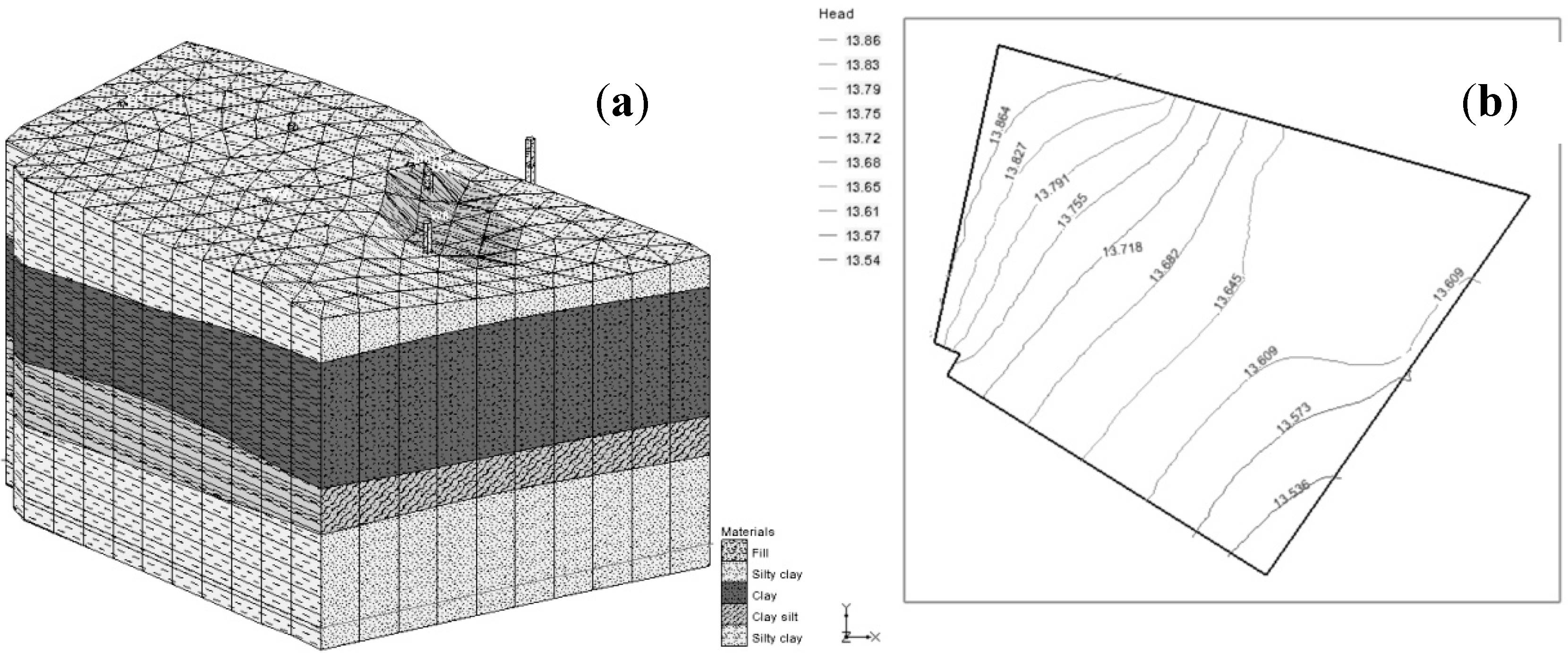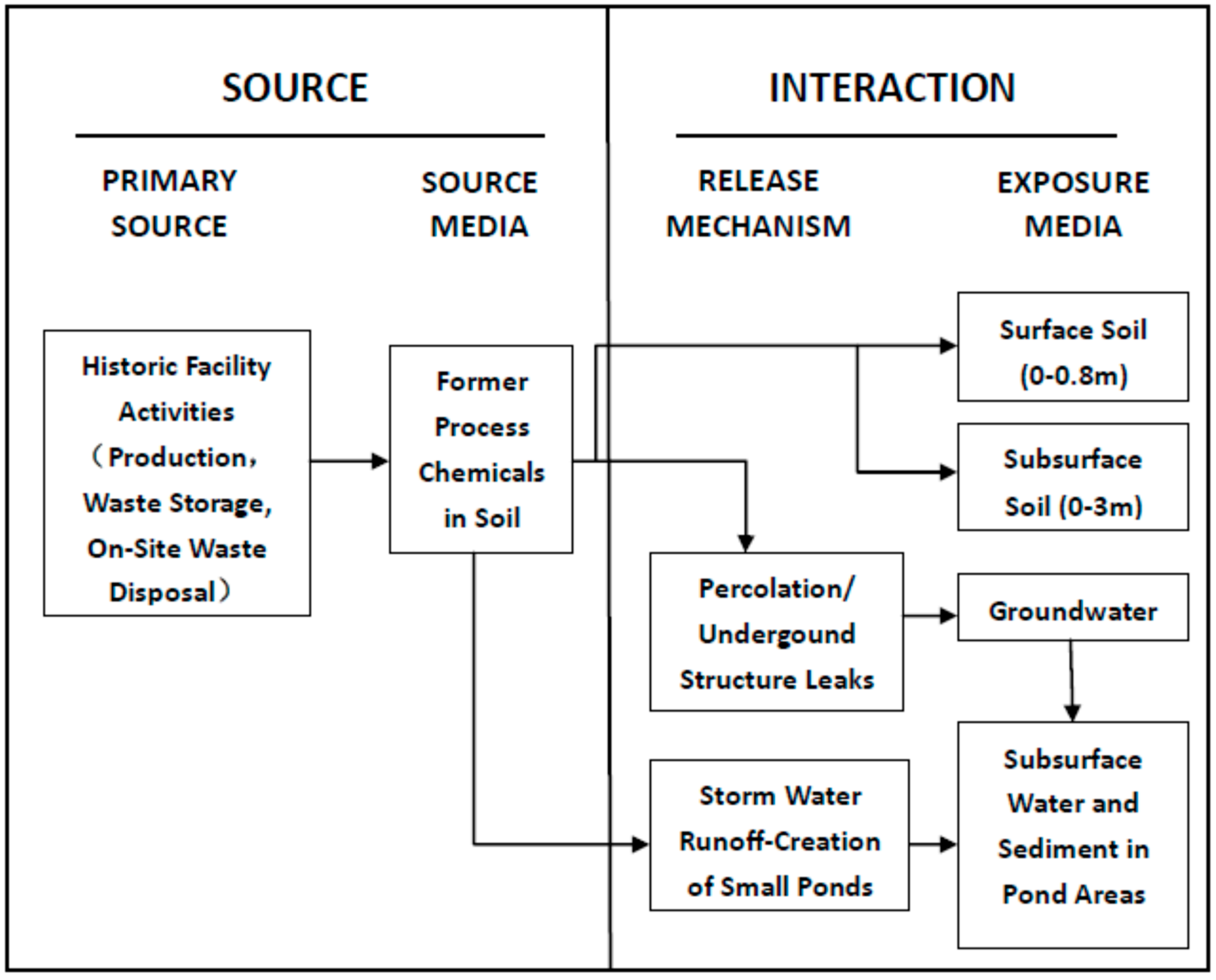3.1. Soils
From 2011 to 2014, three field investigations were conducted to evaluate the contamination levels at the Luhe site. For the first and second investigations, a total of nine soil samples were collected. None of the concentrations of VOCs or SVOC contaminants exceeded their applicable SLSRAS, DIV-S, or USEPA PRG screening values, where applicable screening values were available. During the third investigation, an additional 30 soil samples were collected for VOC and SVOC analysis. While low levels of ethylbenzene, chlorobenzene, 1,3-dichlorobenzene, and 1,4-dichlorobenzene were detected in soil samples collected from location S4, no contaminant was observed at a concentration above Dutch Intervention Values for Soils (DIV-S) (
Table 1). Unfortunately, there are no relevant Dutch Target Values for Soil (DTV-S) for the contaminants found at the site, and SLSRAS for only a limited number of chemicals. In addition, there are not yet any applicable guidelines in China for the de novo derivation of risk-based screening values. Optical brightener PF was detected in soils at 2 mg/g from location SW5, yet this chemical does not appear to be a “typical” soil or groundwater contaminant found at former manufacturing sites that are or have been investigated, either in China or elsewhere. These results clearly demonstrate the need for China to develop risk-based screening levels for soils and groundwater, or adopt and supplement those already developed by the US, The Netherlands, or other countries.
3.3. Conceptual Model
A conceptual model is one of the key elements of site investigations and the remediation process. It serves as both a communication tool and an illustration of contaminant movements through environmental media and the pathways by which those contaminants reach (or not) important receptors such as humans or wildlife [
12,
13]. It is evergreen, and updated throughout the investigation phase as new data become available. Over the course of this work, the Luhe site underwent substantial physical changes including the demolition of all site buildings and the removal of subsurface utilities. This activity tended to complicate some of our soil and groundwater investigations, because the entire surficial soils were modified by the use of heavy equipment such as excavators and hauling trucks, among others. Nevertheless, in one aspect, it was fortunate that these modifications happened during our study. It demonstrated how such sites in China may be subject to clearing and redevelopment, regardless of where they might be in relation to the investigation and identification of potential remedial actions. To our knowledge, these changes did not result in any observable changes to or impacts on the nearby residential areas.
The details above are important to the risk assessors and decision makers since they are directly related to developing the appropriate exposure scenarios that need to be considered in the human health risk assessment and for future risk communication to the local public. They also illustrate a fundamental difference in the length of time allowed for investigations and remedial actions in China compared to the process in the US, where investigations and remediation can take many years, especially on larger, more complex sites.
With respect to the groundwater, developing a site conceptual model required that the source, type, and magnitude of contamination be determined, as well as collecting data on the physical characteristics of the surficial and subsurface soils (
Figure 2a). A clay layer was found at approximately four meters below the ground surface (bgs), which, fortunately, appears to be acting as a confining unit (i.e., aquitard) to the movement of groundwater and contaminants under the site. However, a discontinuous perched water zone was found above this clay layer. The apparent groundwater flow in this perched zone was found to be from northwest to southeast based on the groundwater level measurements collected from the shallow monitoring wells (
Figure 2b). A semi-confined aquifer was found beneath the clay, with an apparent groundwater flow from north to south across the site based on the groundwater level measurements collected from the deeper monitoring wells.
Figure 3 shows the details of the Source-Pathway-Exposure model for soil, based on these various field investigations. The Exposure-Routes-Receptor Model for the site is shown in
Table 3. Under Chinese guidelines, contaminated land is divided into two categories: “sensitive”, and “non-sensitive”. Sensitive land includes land that will be used for non-industrial purposes, such as housing, recreation, etc., whereas non-sensitive land will be used for industrial purposes. In both categories, contaminated land is subject to specific input variables for estimating the potential exposure and risks to human receptors. For the Luhe site, considered non-sensitive land, exposure estimates for adults are characterized by a long exposure duration and high exposure frequency. In addition, exposure estimates are only focused on adults, both for carcinogens and non-carcinogens.
The completion of exposure and hazard assessments for non-sensitive land presented some challenges and concerns in this study. First, this category of land use only considers potential risks to human health and does not include an evaluation of potential exposures or hazards for ecological receptors. This could be problematic because groundwater can be an important pathway for carrying subsurface contaminants to surficial areas such as ponds, lakes, rivers, and estuaries. Under that scenario, the movement of contaminants in groundwater that is later expressed in surface water bodies could potentially lead to unacceptable exposures to humans and ecological receptors. Because that potential exposure scenario is not required under the current guidelines, potential risks to humans and ecological receptors could go undetected. For our work at the Luhe site, this potential problem will be addressed in our future evaluations given that groundwater is a critical environmental media which should also be considered.
Second, this land-use category only considers human adults, but not children, as receptors that need to be evaluated. During our investigations, we observed children traversing the site using the small paved road, yet their potential exposure to contaminants in soil and groundwater were not evaluated. Hence there is uncertainty about this exposure scenario, as well as the scenario whereby wind-borne dusts that carry contaminants from the site, make their way into homes in the nearby village. This too is an issue that should be evaluated in future studies at the LuHe site.
Third, the model does not consider human exposure through the dietary ingestion route. Our investigations showed that small vegetable gardens have been and may continue to be grown adjacent to the site. In this case, there is some potential for vegetables to be contaminated through the uptake of soil-borne contaminants, or from those contaminants that might be deposited through dust settling on the vegetables. This latter point is particularly relevant in China as the rapid expansion of urban, residential areas may have taken place on former manufacturing lands that have not been properly investigated or remediated. It is also known that urban dust that settles on streets, homes, and perhaps vegetables may contain contaminants posing some level of risk to humans [
14,
15]. Since the potential for contaminants to reach edible crops was noted, samples of soils from the small garden plots were taken randomly and analyzed by the Supervision and Testing Center of East China Mineral Resources of Ministry of Land and Resources. Collection of the soil samples generally followed the methods outlined previously. The analytical results from sampling those soils are shown in
Supplemental Materials, Part A: Table S2.
3.4. Risk Assessment
As a first step in the risk assessment process, we reviewed our results from the soil and groundwater investigations to determine which of the various contaminants would be carried forward into our initial assessment. Typically, the analytical results from sampling environmental media are screened against conservative risk-based values developed by a regulatory agency, or other groups that would be appropriate for the specific country. Those contaminants found to exceed these screening values are then carried into the more detailed risk assessment. It is at this juncture in the risk assessment for the site that we deviated from the typical approach. We elected to select final contaminants of concern (COCs) and carry them into the risk assessment based on two criteria: (1) detecting them in a media at or above the Dutch screening values (DTV); and (2) having sufficient toxicological data on the chemical for conducting the hazard (toxicity) assessment. There were limited toxicity data for both PF and no relevant Dutch screening values for PF. As a result, PF was not carried forward into the risk assessment, and thereby contributed to an uncertainty that may need to be addressed in future efforts. Chemicals that met the criteria above and which became final COCs were benzene, toluene, xylenes, ethylbenzene, chlorobenzene, 1,4-dichlorobenzene, and 1,2,4-trichlorobenzene.
3.4.1. Exposure Assessment
For non-sensitive land, the exposure rate calculations for carcinogenic and non-carcinogenic contaminants in soil and groundwater are shown in
Supplemental Materials, Part A: Tables S3 and S4, respectively. The models for calculating exposure rates are found in
Supplemental Materials —Part B1, and the values of the parameters used to calculate the exposure rate are listed in
Supplemental Materials—Part C. As mentioned above, the values of the parameters applied to calculate the exposure rate were mostly those developed in the US, and as such they may not reflect exactly the characteristic of similar items in China. For example, they do not reflect building type and structure, and the types of soil, etc., found in China. In the future, those parameters will need to be developed and refined based on investigations and basic studies at the various contaminated waste sites in China.
3.4.2. Toxicity Assessment
The potential hazardous effects on human health via different exposure routes were analyzed, including those for carcinogens and non-carcinogens. This analysis also included an evaluation of dose-response associations and mechanisms of toxicity (hazard) for the COCs, as required and/or recommended by the Chinese guidelines. Toxicity parameters for carcinogenic effects include the inhalation unit risk (IUR), inhalation cancer slope factor (SFi), oral ingestion induced cancer slope factor (SFo), and dermal contact-induced cancer slope factor (SFd). The values of the toxicity parameters for carcinogenic effects for the COCs are shown in
Supplemental Materials, Part A: Table S5. The SFi is obtained through extrapolation of IUR in Part B2; the SFd is obtained through extrapolation of SFo, also provided in Part B2.
The toxicity parameters for non-carcinogenic effects include the inhalation reference concentration (RfC), inhalation reference dose (RfDi), oral ingestion reference dose (RfDo), and dermal contact reference dose (RfDd). The values of the toxicity parameters for the non-carcinogenic effects of COCs are given in
Supplemental Materials, Part A: Table S5. The RfDi and RfDd are also obtained through the Equations provided in Part B2. The toxicity values for contaminants in the new guidelines are limited, particularly for PF and 1,2,4-tricholorobenzene, which are both found at the site. It is expected that as China’s national remediation program evolves, much of the data currently needed to refine these input values and support risk assessments will be obtained and incorporated into future regulatory guidelines.
The physical and chemical properties of COCs required for risk assessment calculations include the dimensionless Henry’s constant (H’), air diffusion coefficient (Da), water diffusion coefficient (Dw), soil-organic carbon allocation coefficient (Koc), and water solubility (S). The values of the physical and chemical parameters of COCs are given in
Supplemental Materials, Part A: Table S5. Other relevant parameters include the digestive tract absorption factor (ABSgi), skin absorption factor (ABSd), and the absorption factor for oral ingestion (ABSo).
3.4.3. Risk Characterization
Characterizing risks generally follows two approaches: the hazard quotient/hazard index, or a probabilistic approach. The Chinese guidelines provide some flexibility for this step in the risk assessment process. The risks are characterized by calculating the hazard quotient (HQ—systemic toxicity) and carcinogenic risk (CR) of COCs from samples (soils, groundwater, etc.) collected at the various sampling points. As shown in
Supplemental Materials, Part A: Table S5, there are no recommended toxicity parameters for the potential carcinogenic effects of chlorobenzene. The results shown in
Supplemental Materials, Part A: Tables S3 and S4, were then applied to the models needed for calculating the potential risks of the individual COCs. This included applying the results to the six exposure pathways for soils and three pathways for groundwater, as required, and are shown in Part B3.
The initial risk characterization was based on the previous results and are summarized in
Table 4, which shows the concentration(s) for each COC that were applied to estimating risks. In this case, only the COCs in soils and groundwater at sampling location S4 were detected at levels above the Dutch DIV screening values. Unfortunately, the data set for this aspect of the risk characterization step was too limited for a more robust evaluation, and in the future and especially for larger and complicated sites, statistical methods will be needed for calculating more representative concentrations or ranges of concentrations of relevant COCs. This would also allow for calculating risk ranges, rather than single point estimates, something that is of interest to risk managers as they determine what action will be needed to protect human health and the environment.
The results of calculating HQ and CR are shown in
Table 5. The guidelines define an acceptable risk as an HQ of 1 or less, while the acceptable level of CR (ACR) is 1.00 × 10
−6 or less. The bold numbers in
Table 5 highlight where the HQ or CR of an individual contaminant was greater than the acceptable risk level. In those instances, the guidelines indicate that the area where the contamination was found (around S4) should be designated as having an unacceptable risk. Among the nine different exposure routes evaluated, the groundwater consumption route was found to contribute most to the potential harm to human health for both non-carcinogenic and carcinogenic effects.
Figure 4 provides a relative contribution from the individual routes, taking 1,4-trichlorobezene as being representative of COCs. The recommended models that were used to develop these estimates are provided in Part B4. Dermal contact with soil (dcs) greatly contributes to the potential.
The total risk among all soil exposure routes was as high as 84.10% on an HQ basis (HQ_S in
Figure 4) and 94.30% on a CR basis (CR_S in
Figure 4). For the three routes associated with exposure to groundwater ingestion, cgw contributes the largest portion (80.89%) on an HQ basis (HQ_G in
Figure 4), and 94.41% on a carcinogenic risk basis (CR_G in
Figure 4). Considering all nine exposure routes, the contribution from groundwater consumption (cgw) is the most significant (98.96 of HQ_All basis and 80.73 of CR_All). These results clearly illustrate that the potential for risk to humans from consuming contaminated groundwater could be problematic, and should be addressed in any proposed risk management actions.
3.4.4. Calculating Risk Control Values
The guidelines provide steps for calculating risk control values, which are those values that will be used to determine the level of remediation that might be required for sites where unacceptable risks have been estimated. Calculating soil and groundwater risk control values, based on non-carcinogenic and carcinogenic effects, follows the same process as noted for estimating risks (either HQ or CR). An acceptable HQ for an individual COC is 1 or less, and for the CR of an individual contaminant, the acceptable level is 10 × 10
−6 or less. The recommended models for calculating soil and groundwater risk control values are given in
Supplemental Materials—Part B4 and the relevant parameter values are given in
Supplemental Materials—Part C.
The calculated risk control values for soil and groundwater based on non-carcinogenic and carcinogenic effects are shown in
Table 6. When determining the soil and groundwater remediation target values at the contaminated site, the soil and groundwater risk control values should be calculated as primary reference values based on the risk assessment model. The calculated soil risk control values based on non-carcinogenic and carcinogenic effects, and groundwater risk control values based on non-carcinogenic and carcinogenic effects, are then compared (
Table 6). The bold numbers are the risk control values of individual contaminants for soil and groundwater at the Luhe site, respectively. This comparison indicates that the soil remediation target value, as well as the cleanup value for ethylbenzene, is 1.65 mg/kg, and that the groundwater remediation target value is 2.15 × 10
−2 mg/L. For benzene, ethylbenzene, and 1,4-dichlorobenzene, the risk control values were calculated based both on non-carcinogenic and carcinogenic effects (
Table 6). These results show that the risk control values based on non-carcinogenic effects are almost two orders of magnitude higher than the risk control values based on carcinogenic effects.
The acceptable carcinogenic risk (ACR) of an individual contaminant for humans is 1.00 × 10−6 in the new guidelines, and perhaps deserves some reflection. For example, as China is still developing and working to undertake remediation at multiple sites around the country, one might consider whether an ACR of 1.00 × 10−6 is an appropriate value to apply at this time. Similar to remedial policies, regulations, and guidelines that began and evolved in the US and Europe, the current guidelines in China are likely to be revised over time, and it could be that setting a less stringent ACR at this time might allow more sites to be addressed, and in a shorter time period, than might be the case with a more stringent ACR. An ACR range of 1.00 × 10−4 to 1.00 × 10−5 has been applied generally for industrial sites in other countries, thus providing a less stringent but more financially practical approach. In addition, at this time, the guidelines only provide a single point estimate of potential exposure, rather than ranges or statistically-based estimates. As the experience base in remediating sites in China grows, a risk-range could be considered in determining what will be the appropriate risk control values, as well as the cleanup number, in the future.










